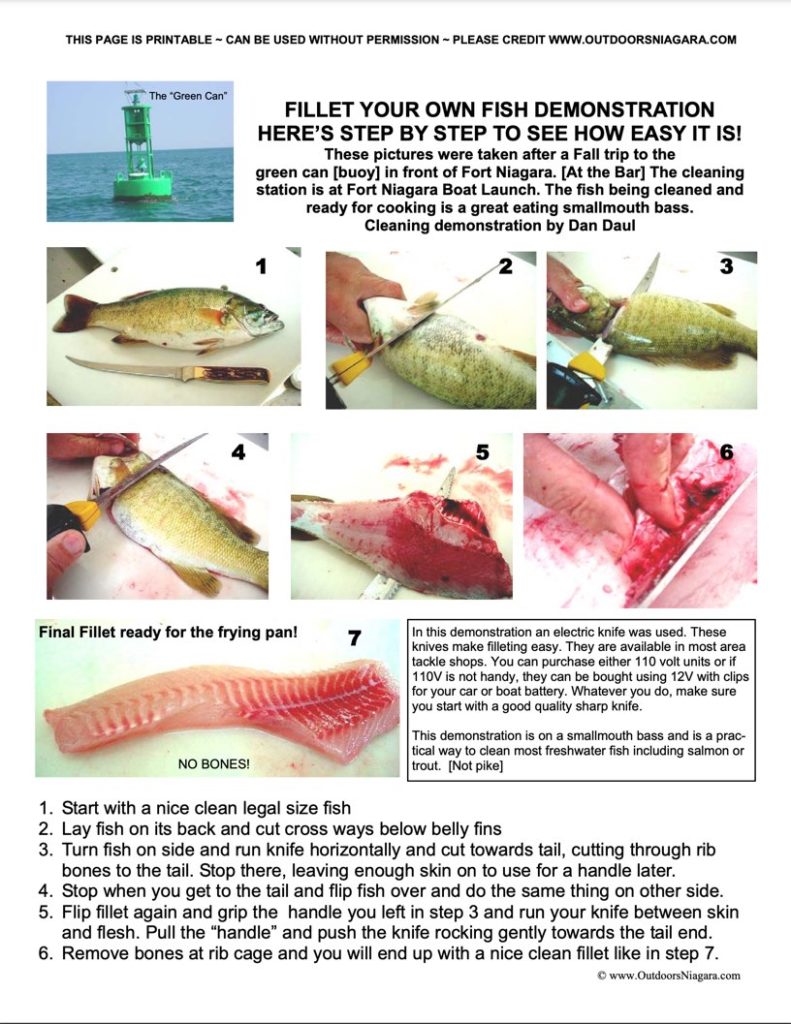If not knowing how to clean a fish is holding you back, don’t worry.
Inside this post, we will teach you how to fillet a smallmouth bass.
You can clean fish at home, but a better place is right at the lake or river.
Most fishing locations with a boat launch have a fish cleaning station.
You will need a few items to clean your catch safely, and as you read this, we will give you tips and tricks to make cleaning a fish successfully less work and more manageable.
Contents
How to clean and fillet a smallmouth bass?
Before you get started, you will need a steady, flat, hard surface, water, a filet knife, and of course, a fish.
A filet knife is long and thin, and those attributes are essential.
The thinness of the blade helps it to flex around the contours of the fish.
A fish has an oval-shaped body, and the knife will need to be flexible, strong, and sharp.
There are a few things to do before you get to cleaning the fish.
- Make sure the surface on which you are cleaning is washable and clean. You can cover the surface with newspaper or butcher paper to provide a clean surface. Butcher paper has a waxy coating on one side and is ideal as it will stay together. Newspaper, when wet, begins to deteriorate.
- You will need a receptacle to put in the fish guts and bones.
- Make sure your filet knife is sharp.
When you have finished those three chores, you are ready to start cleaning the fish.
Here is the step-by-step process for how to clean a smallmouth bass.
- Lay the fish on the surface lengthwise in front of you.
- Gut the fish. Take your knife and insert it into the anus. Make a cut that runs up the belly to the point where the two belly fins are below the gills.
- Remove all the guts and discard. If the gut cavity is messy, wash it out with running water.
- Turn the bass on its back and cut just underneath the fins and below the gill opening and all the way to the spine. Do not sever the spine.
- Place the fish on its side. Starting with the vertical cut at the belly fins, insert the knife horizontally and cut towards the tail. The goal here is to cut down the spin, severing all of the rib bones. It would be best if you stopped before you reach the tail, keeping about one inch of skin between the spine and tail intact.
- At this point, you can unfold the entire side of the fish onto the surface, with it still attached by the skin at the tail. Now it is time to remove the skin from the fish. To do so, turn the knife parallel to the skin. Carefully slide the knife between the skin and the meat. With a very slow and gentle rocking motion, saw the knife down the filet keeping it between the skin and the flesh. The flatter you can keep the knife, with the edge gliding along the surface of the skin, the better the process is. If you find chunks of meat left in spots still attached to the skin, readjust the knife angle.
- Remove the rib bones from the filet. The process of removing the rib bones is easy. Make a small slit between the rib bones and the filet. Lift on the rib bones where you’ve made that slide, and begin to saw gently between the ribs and the meat. The rib bones are attached to the meat by a thin sheet of connection material. Keep the knife’s edge in that material, and the rib bones will come off the meat, leaving a lovely filet that is neat.
- Turn the fish over and repeat for the other side.
Tips or Tricks?
There are a few tips that we’ve mentioned. We will list them here again.
- If you clean fish at the lake, be sure to carry a roll of butcher’s paper with you. It will keep your work area clean and your fish filets safe from residue bacteria.
- A small knife sharpener will always be your friend. A sharp knife makes filleting fish easy and the results perfect.
- A small ice chest or portable cooler will keep your fish filets cold and safe to consume.
- Practice will improve your fileting technique and efficiency.
Do you have to gut bass?
Yes. Gut all fish as their intestines have bacteria you do not want to eat.
Gutting a fish is easy, even if you don’t filet the fish.
Can you eat smallmouth bass skin?
You can eat smallmouth bass skin and the skin from any of the members of the bass family of fish.
It is a good idea to descale it, which you can do by dragging the blade of your filet knife against the grain of the scales.
It is a messy job but worthwhile.
Can you hold smallmouth bass by the mouth?
Yes, you can hold a smallmouth bass by the mouth.
Hold the fish vertically so that mouth is up and the tail is down.
Doing so takes all the stress off of the jaw.
You can then unhook the beast and let it go or put it in your icebox.
Is smallmouth bass good to eat?
They are good to eat. Most bass fish are pretty delicious.
The fresher the fish, the better the meal.
If you are fishing remotely, plan on a riverbank fish fry.
At some of the best world-class fishing lodges, a shore lunch, including a fish fry, is part of the deal, and it’s an excellent way to have lunch.
Conclusion
Getting started cleaning your fish may seem like a difficulty.
But, the truth is that learning to filet a smallmouth bass or any other type of fish is straightforward.
With good fishing tools, and technique you will be fileting smallmouth bass safely and quickly.
Plus, the technique we show in this blog is perfect the same process for largemouth bass and other fish too.








